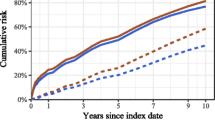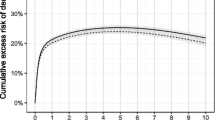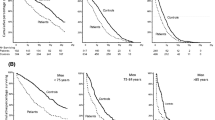Abstract
Summary
We used a large population-based health care database to determine the impact of common co-morbidities on hip fracture risk amongst elderly men. We demonstrated that diabetes, chronic obstructive pulmonary disease, renal failure, HIV infection, dementia, and cerebrovascular disease are independent predictors of hip fracture, as is a Charlson score of ≥3.
Introduction
Risk factors for hip fractures in men are still unclear. We aimed to identify common co-morbidities (amongst those in the Charlson index) that confer an increased risk of hip fracture amongst elderly men.
Methods
We conducted a population-based cohort study using data from the SIDIAP Q database. SIDIAPQ contains primary care and hospital inpatient records of a representative 30 % of the population of Catalonia, Spain (>2 million people). All men aged ≥65 years registered on 1 January 2007 were followed up until 31 December 2009. Both exposure (co-morbidities in the Charlson index) and outcome (incident hip fractures) were ascertained using ICD codes. Poisson regression models were fitted to estimate the effect of (1) each individual co-morbidity and (2) the composite Charlson index score, on hip fracture risk, after adjustment for age, body mass index, smoking, alcohol drinking, and use of oral glucocorticoids.
Results
We observed 186,171 men for a median (inter-quartile range) of 2.99 (2.37–2.99) years. In this time, 1,718 (0.92 %) participants had a hip fracture. The following co-morbidities were independently associated with hip fractures: diabetes mellitus, chronic obstructive pulmonary disease (COPD), renal failure, HIV infection, dementia, and cerebrovascular disease. A Charlson score of ≥3 conferred an increased hip fracture risk.
Conclusion
Common co-morbidities including diabetes, COPD, cerebrovascular disease, renal failure, and HIV infection are independently associated with an increased risk of hip fracture in elderly men. A Charlson score of 3 or more is associated with a 50 % higher risk of hip fracture in this population.



Similar content being viewed by others
References
Kanis JA, Odén A, McCloskey EV, Johansson H, Wahl DA, Cooper C, IOF Working Group on Epidemiology and Quality of Life (2012) A systematic review of hip fracture incidence and probability of fracture worldwide. Osteoporos Int 23:2239–2256
Pagès-Castellà A, Carbonell-Abella C, Avilés FF, Alzamora M, Baena-Díez JM, Laguna DM, Nogués X, Díez-Pérez A, Prieto-Alhambra D (2012) Burden of osteoporotic fractures in primary health care in Catalonia (Spain): a population-based study. BMC Musculoskelet Disord. doi:10.1186/1471-2474-13-79
Brauer CA, Coca-Perraillon M, Cutler DM, Rosen AB (2009) Incidence and mortality of hip fractures in the United States. JAMA 302:1573–1579
Cawthon PM (2011) Gender differences in osteoporosis and fractures. Clin Orthop Relat Res 469:1900–1905
Kannegaard PN, van der Mark S, Eiken P, Abrahamsen B (2010) Excess mortality in men compared with women following a hip fracture. National analysis of comedications, comorbidity and survival. Age Ageing 39:203–209
Premaor MO, Compston JE, Fina Avilés F, Pagès-Castellà A, Nogués X, Díez-Pérez A, Prieto-Alhambra D (2013) The association between fracture site and obesity in men: A population-based cohort study. J Bone Miner Res. doi:10.1002/jbmr.1878
Nguyen TV, Eisman JA, Kelly PJ, Sambrook PN (1996) Risk factors for osteoporotic fractures in elderly men. Am J Epidemiol 144:255–263
Hannan MT, Felson DT, Dawson-Hughes B, Tucker KL, Cupples LA, Wilson PW, Kiel DP (2000) Risk factors for longitudinal bone loss in elderly men and women: the Framingham Osteoporosis Study. J Bone Miner Res 15:710–720
Drake MT, Murad MH, Mauck KF, Lane MA, Undavalli C, Elraiyah T, Stuart LM, Prasad C, Shahrour A, Mullan RJ, Hazem A, Erwin PJ, Montori VM (2012) Clinical review. Risk factors for low bone mass-related fractures in men: a systematic review and meta-analysis. J Clin Endocrinol Metab 97:1861–1870
Charlson ME, Pompei P, Ales KL, MacKenzie CR (1987) A new method of classifying prognostic comorbidity in longitudinal studies: development and validation. J Chron Dis 40:373–383
Souza RC, Pinheiro RS, Coeli CM, Camargo KR (2008) The Charlson comorbidity index (CCI) for adjustment of hip fracture mortality in the elderly: analysis of the importance of recording secondary diagnoses. Cad Saúde Pública 24:315–322, Rio de Janeiro
Soler PA, Paterna Mellinas G, Martınez Sanchez E, Lopez Jimenez E (2010) Evaluación de la comorbilidad en la poblacion anciana: utilidad y validez de los instrumentos de medida. Rev Esp Geriatr Gerontol 45:219–228
García-Gil Mdel M, Hermosilla E, Prieto-Alhambra D, Fina F, Rosell M, Ramos R, Rodriguez J, Williams T, Van Staa T, Bolíbar B (2011) Construction and validation of a scoring system for the selection of high-quality data in a Spanish population primary care database (SIDIAP). Inform Prim Care 19:135–145
Andrews G, Faulkner D, Andrews M (2004) A Glossary of Terms for Community Health Care and Services for Older Persons. WHO. http://www.who.int/kobe_centre/ageing/ahp_vol5_glossary.pdf
Quan H, Sundararajan V, Halfon P, Fong A, Burnand B, Luthi JC, Saunders LD, Beck CA, Feasby TE, Ghali WA (2005) Coding algorithms for defining comorbidities in ICD-9-CM and ICD-10 administrative data. Med Care 43:1130–1139
Violán C, Foguet-Boreu Q, Hermosilla-Pérez E, Valderas JM, Bolíbar B, Fàbregas-Escurriola M, Brugulat-Guiteras P, Muñoz-Pérez MA (2013) Comparison of the information provided by electronic health records data and a population health survey to estimate prevalence of selected health conditions and multimorbidity. BMC Public Health 13:251
Ramos R, Balló E, Marrugat J, Elosua R, Sala J, Grau M, Vila J, Bolíbar B, García-Gil M, Martí R, Fina F, Hermosilla E, Rosell M, Muñoz MA, Prieto-Alhambra D, Quesada M (2012) Validity for use in research on vascular diseases of the SIDIAP (Information System for the Development of Research in Primary Care): the EMMA study. Rev Esp Cardiol (Engl Ed) 65:29–37
Elixhauser A, Steiner C, Harris DR, Coffey RM (1998) Comorbidity measures for use with administrative data. Med Care 36:8–27
Byberg L, Gedeborg R, Cars T, Sundström J, Berglund L, Kilander L, Melhus H, Michaëlsson K (2012) Prediction of fracture risk in men: a cohort study. J Bone Miner Res 27:797–807
Li B, Evans D, Faris P, Dean S, Quan H (2008) Risk adjustment performance of Charlson and Elixhauser comorbidities in ICD-9 and ICD-10 administrative databases. BMC Health Serv Res 8:12
Lewis CE, Ewing SK, Taylor BC, Shikany JM, Fink HA, Ensrud KE, Barrett-Connor E, Cummings SR, Orwoll E (2007) Osteoporotic Fractures in Men (MrOS) Study Research Group. Predictors of non-spine fracture in elderly men: the MrOS study. J Bone Miner Res 22:211–219
Pouwels S, Lalmohamed A, Leufkens B, de Boer A, Cooper C, van Staa T, de Vries F (2009) Risk of hip/femur fracture after stroke: a population-based case-control study. Stroke 40:3281–3285
Raska I Jr, Broulík P (2005) The impact of diabetes mellitus on skeletal health: an established phenomenon with inestablished causes? Prague Med Rep 106:137–148
Oei L, Zillikens MC, Dehghan A, Buitendijk GH, Castaño-Betancourt MC, Estrada K et al (2013) High bone mineral density and fracture risk in type 2 diabetes as skeletal complications of inadequate glucose control: the rotterdam study. Diabetes Care 36:1619–1628
Zhao Y, Shen L, Ji HF (2012) Alzheimer's disease and risk of hip fracture: a meta-analysis study. ScientificWorldJournal 2012:872173. doi:10.1100/2012/872173
Demirbag D, Ozdemir F, Kokino S, Berkarda S (2005) The relationship between bone mineral density and immobilization duration in hemiplegic limbs. Ann Nucl Med 19:695–700
Dam TT, Harrison S, Fink HA, Ramsdell J, Barrett-Connor E (2010) Osteoporotic Fractures in Men (MrOS) Research Group. Bone mineral density and fractures in older men with chronic obstructive pulmonary disease or asthma. Osteoporos Int 21:1341–1349
Lo Re V 3rd, Volk J, Newcomb CW, Yang YX, Freeman CP, Hennessy S, Kostman JR, Tebas P, Leonard MB, Localio AR (2012) Risk of hip fracture associated with hepatitis C virus infection and hepatitis C/human immunodeficiency virus coinfection. Hepatology 56:1688–1698
Triant VA, Brown TT, Lee H, Grinspoon SG (2008) Fracture Prevalence among Human ImmunodeficiencyVirus (HIV)-Infected Versus Non-HIV-Infected Patients in a Large U.S. Healthcare System. J Clin Endocrinol Metab 93:3499–3504
Güerri-Fernandez R, Vestergaard P, Carbonell C, Knobel H, Avilés FF, Castro AS, Nogués X, Prieto-Alhambra D, Diez-Perez A (2013) HIV infection is strongly associated with hip fracture risk, independently of age, gender, and comorbidities: a population-based cohort study. J Bone Miner Res 28:1259–1263
Yin MT, Kendall MA, Wu X, Tassiopoulos K, Hochberg M, Huang JS, Glesby MJ, Bolivar H, McComsey GA (2012) Fractures after antiretroviral initiation. AIDS 26:2175–2184
Acknowledgments
We would like to acknowledge the health professionals (general practitioners and nurses) responsible for the collection of these data, as well as to the patients involved.
Conflicts of interest
CR: none; DPA: unrestricted research grants from BIOIBERICA SA and AMGEN; PO: none; PE: none; FF: none; XN: advisory board Amgen, educational speaker for Amgen, Lilly and MSD; CC: none; ADP: Advisor or speaker for Lilly, Amgen, Novartis, Pfizer and Active Life Scientific; JGM: none.
Author information
Authors and Affiliations
Corresponding author
Additional information
Conflict of interest
CR: none; DPA: unrestricted research grants from BIOIBERICA SA and AMGEN; PO: none; PE: none; FF: none; XN: advisory board Amgen, educational speaker for Amgen, Lilly and MSD; CC: none; ADP: Advisor or speaker for Lilly, Amgen, Novartis, Pfizer and Active Life Scientific; JGM: none.
Rights and permissions
About this article
Cite this article
Reyes, C., Estrada, P., Nogués, X. et al. The impact of common co-morbidities (as measured using the Charlson index) on hip fracture risk in elderly men: a population-based cohort study. Osteoporos Int 25, 1751–1758 (2014). https://doi.org/10.1007/s00198-014-2682-9
Received:
Accepted:
Published:
Issue Date:
DOI: https://doi.org/10.1007/s00198-014-2682-9




